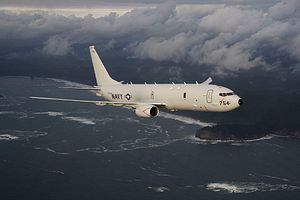On Monday, South Korea’s military announced that it had chosen to purchase Boeing’s P-8 Poseidon maritime patrol aircraft. According to a senior Boeing official cited by Reuters, the total value of the contract is expected to be around $1.7 billion.
South Korea’s main government military procurement arm — the Defense Acquisition Program Administration (DAPA) — said that the Republic of Korea armed forces would purchase the aircraft through the U.S. government’s foreign military sales program. The United States and South Korea are treaty allies.
South Korea has decided “to purchase the latest maritime patrol aircraft for conducting patrol, search and rescue operations through the FMS program from the U.S. government, in consideration of the cost, time schedule, capabilities as well as the legal aspect,” the DAPA said in a press release.
The South Korean military is seeking to take delivery of the P-8s in the early 2020s.
Since the mid-1990s, the Republic of Korea Navy (ROKN) has operated a squadron of P-3C Orion maritime patrol aircraft. The P-8 acquisition will significant bolster the ROKN’s anti-submarine warfare capabilities.
The P-8 series of aircraft are designed for long-range maritime patrol missions and are equipped for anti-submarine warfare, anti-surface warfare, and intelligence, surveillance, and reconnaissance missions.
As the newest generation of surveillance aircraft in use by the U.S. Navy, the P-8 is also designed to operate with a smaller crew size of nine. The aircraft has a range of 1,200 nautical miles and a flight ceiling of 41,000 feet.
The aircraft is equipped with advanced sensors, including an APY-10 radar system. Unlike the older P-3, the P-8A operated by the U.S. Navy does not include a magnetic anomaly detector; the P-8I, the variant purchased by the Indian Navy, does include this feature.
In addition to the U.S. Navy and the Indian Navy, the Royal Australian Air Force also operates the P-8. The ROKN will become the fourth navy to operate this aircraft. The Royal New Zealand Air Force is expected to procure the aircraft in due time, but has yet to conclude an order.
The ROKN’s primary adversary, North Korea, operates a large fleet of submarines. While most of these are outdated and loud, the Korean People’s Navy compensates with sheer numbers.
Significantly, in recent years, North Korea has developed a burgeoning ballistic missile submarine capability. It has one Sinpo-class ballistic missile submarine (SSB) capable of firing the nuclear-capable KN11/Pukguksong-1 submarine-launched ballistic missile.
A high-endurance maritime surveillance aircraft like the P-8 could allow the ROKN to better surveil waters in the Sea of Japan where North Korea’s SSB would likely operate if deployed in a crisis. The submarine has never traveled far from its home port of Sinpo on North Korea’s eastern coast.

































